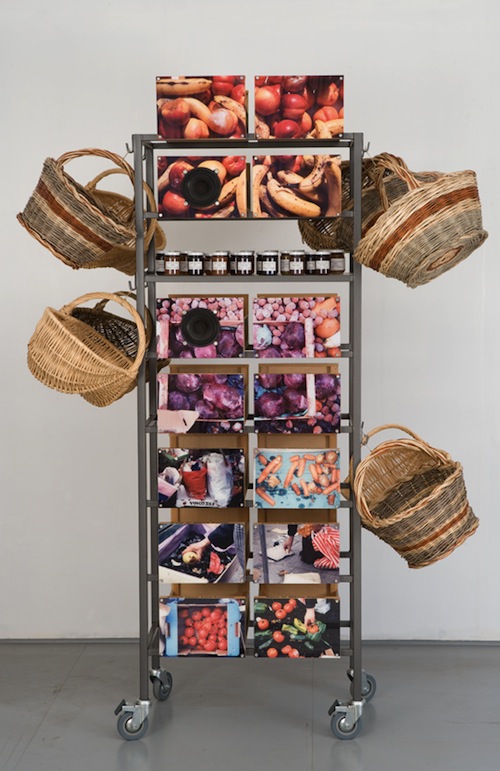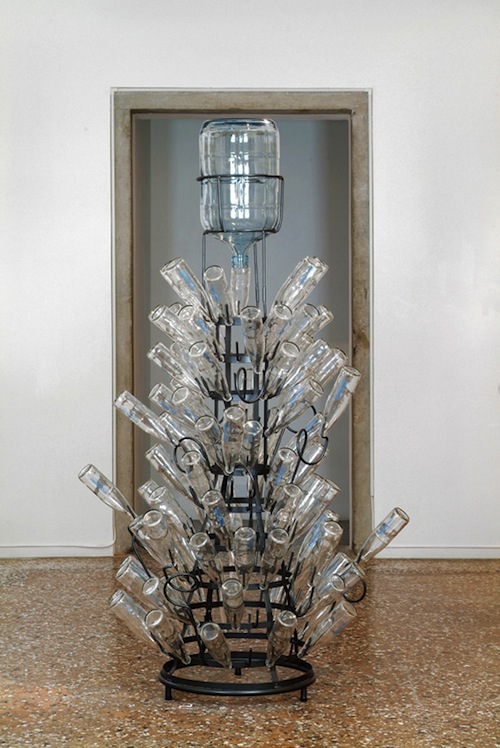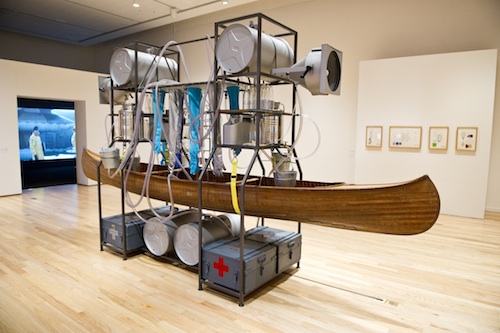
Lucy + Jorge Orta’s Food-Water-Life installation at Tufts University Art Gallery, 2012. Left: “Mexican Kitchen,” 2002-2008. Right, rear: “HortiRecycling Enterprise, act II–Conservation Unit,” 1997-2005. Photo: Alonso Nichols, Tufts University Photography.
For more than two decades, wife-husband team Lucy + Jorge Orta have contemplated global problems in food, water, shelter and land. Before meeting in early 1990s Paris, Lucy studied fashion-textile design in England while Jorge studied fine art and architecture in Argentina. Their individual practices were socially engaged and participatory. When they began to collaborate, the artists merged and expanded their methods of involving publics, art folks and non-art folks alike, in the process of making. Their activities range from hosting community banquets and recycling food waste to purifying water and issuing limited-edition passports. All of this is manifest in Food-Water-Life, the Ortas’ first major traveling exhibition in the United States, now up at Tufts University Art Gallery in Boston.
The Ortas founded their design studio five years before Nicolas Bourriaud coined the term “relational aesthetics” and their collaborative processes continue to be associated with this rubric. That seems an old-fashioned way of talking about their work today. The art world has since moved on to “social practice.” Although this field is nebulous and, apparently, suffering from identity crisis, one thing about social practice art is clear to me: food is a favorite ingredient. Being the great connector of people, it makes perfect sense as medium, as catalyzer. Food is also inseparable from issues of climate change, land and sustainability with which so many social practitioners are concerned. Food-Water-Life is an excellent instance of this or the artist as activist-slash-humanitarian. The Ortas’ large-scale sculptures and contraptions symbolize the potential of art to effect change in global conditions that go unnoticed, unchecked, unresolved. The artists raise awareness about, for instance, the growing scarcity of drinkable water, and the 13.6 percent of the estimated world population that suffers from hunger. To this, the Ortas manage to bring optimism, whimsy and lots of color.
Food-Water-Life is divided into the three sections and begins with the Ortas’ various food projects. The HortiRecycling series consists of rolling carts used to process discarded produce into preserves, and shelving units used to display these pickles, jams and syrups. HortiRecycling has roots in Lucy Orta’s mid-1990s project All in One Basket that began with her gathering of unsold fruits and vegetables from Paris street markets. She was thinking like a dumpster-diver long before it was popular. The HortiRecycling series represents the idea that “sustainable development has to be embedded in everyday life, through the responsibility of every person to avoid excessive, superfluous consumption.” For the Ortas, that frequently means turning small and unassuming structures into amazingly productive spaces. HortiRecycling—Mexican Kitchen is a cook’s version of a Monster Truck. Colanders, pots, pans, and eating utensils hang above gas stovetops. Below, wooden crates are repurposed as drawers. Spouts and water jugs placed on either side turn the installation into a full-service prep station. But don’t anticipate seeing this kitchen in action at Tufts. Like other works in Food-Water-Life, Mexican Kitchen is a leftover of cooking and eating as public performance, a representation of a happening.
For years, the Ortas have staged the recurring dinner party 70 x 7 The Meal. The artists invite seven people who are each asked to invite a guest. Those seven guests invite seven more people so on and so forth. Held in public and private settings from Europe to California, meals have been sourced from local farms and cooked by celebrity chefs. In pictures, people seated at long banquet tables appear to fill tight alleyways and long stretches of rural property. It’s a magnificent sight. At Tufts, the specially designed plates for these events take center stage, running the entire length of a gallery wall. Even with their artist-designed markings, walking along this line of modern dinnerware felt like shopping at CB2.
The Water section begins with the spectacular OrtaWater—Bottle Rack. Tongue-in-cheek, the artists have mounted reusable glass bottles, labeled with their names, onto a replica of Marcel Duchamp’s readymade. Displayed at the 2005 Venice Biennale, visitors were given these bottles filled with purified water from Venice’s dirty Grand Canal. In this, the Ortas seem to acknowledge the privileges of the very event: bottled water and cultural tourism are both luxuries. Other objects in the OrtaWater series aren’t quite as showy. Many of them are fully-operational and were in fact used to clean the water from the Canal. The monumental structure OrtaWater-Fluvial Intervention Unit is a sort of Noah’s Ark for the 21st century. It symbolizes human survival, our incessant need for drinkable water and also, maybe, how creative models might help to sustain life. Underneath the canoe, water drums, light projectors and other materials of OrtaWater-Fluvial Intervention Unit, two kits with Red Cross emblems signify aid. These call to mind not only sites of war and natural disaster but also Joseph Beuys’s “representations of injury” and antidotes for healing. Other such works include Drop Parachutes rigged with lifesavers to keep people afloat, long plastic gloves to protect people’s skin, and stuffed animals to provide people with comfort.
The exhibition concludes with the section on Life. It summarizes the Ortas’ Antarctic Village—No Borders project. In 2007, the couple made an expedition to the Antarctic Peninsula (shown in the exhibition’s only video) and continue to make work about the location, largely in response to the 1959 Antarctic Treaty signed by 48-member nations. They declared it peaceful territory, articulating a sort of utopia “free from weapons, nuclear activity, and military presence.” As the video confirms, their ideals starkly contrast Antarctica’s harsh terrain and weather conditions. Still, the Ortas literally planted their flag there. Their Métisee Flag, one made up of many, suggests peace will come through the dissolution of boundaries.
The Ortas see their objects as “triggers.” With any luck, they’ll arouse people and incite them to act. In this last corner of the show, viewers can get involved on the spot. In exchange for my name, I became a citizen of Antarctic Village and received an Antarctica Passport, also a limited edition object. Reading the inside of the booklet, I learned that holders are given heavy responsibilities: “Combating all acts of barbarity, to fight against intimidation and poverty, to support social progress, to protect the environment and endangered species….” Flipping back to the cover, I read: “Everyone has the right to move freely beyond the state boundaries to a territory of their choice.” This statement of course resonates with the Ortas’ advocacy for the erasure of borders–which have always had a way of limiting people’s access to food and water. The Life section is more open-ended, not as succinct, as Food and Water. This is perhaps because Antarctic Village is the coming together of many different Orta activities and concerns. But there is one common thread through all three sections: basic human rights.
Food-Water-Life is on view at Tufts through December 16. Lucy Orta will lecture on Tuesday, October 30 in the Alfond Auditorium at the Museum of Fine Arts, Boston. The event is free and open to the public. Food-Water-Life will travel to Wesleyan, Cornell, and DePauw universities, and Otis College of Art and Design.







Pingback: Lucy + Jorge Orta: Food-Water-Life | Nicole J Caruth
Pingback: Sokakta tecavüz girişimi iddiası - Haber, Güncel Haberler, Gündem, Haberler | Haber, Güncel Haberler, Gündem, Haberler